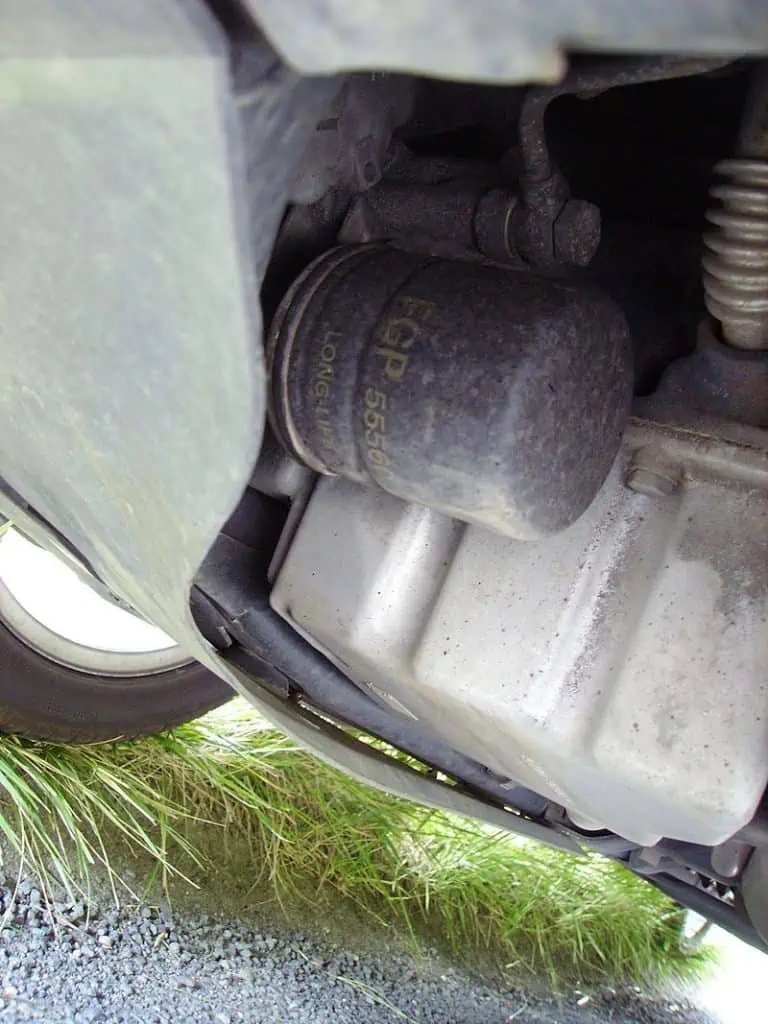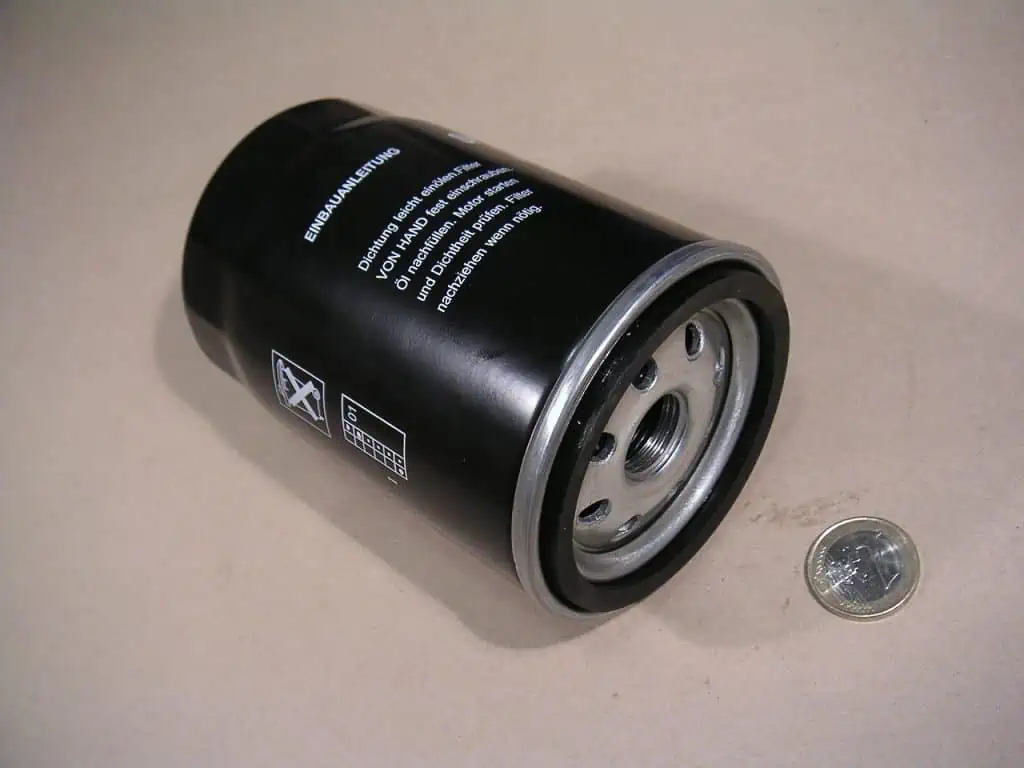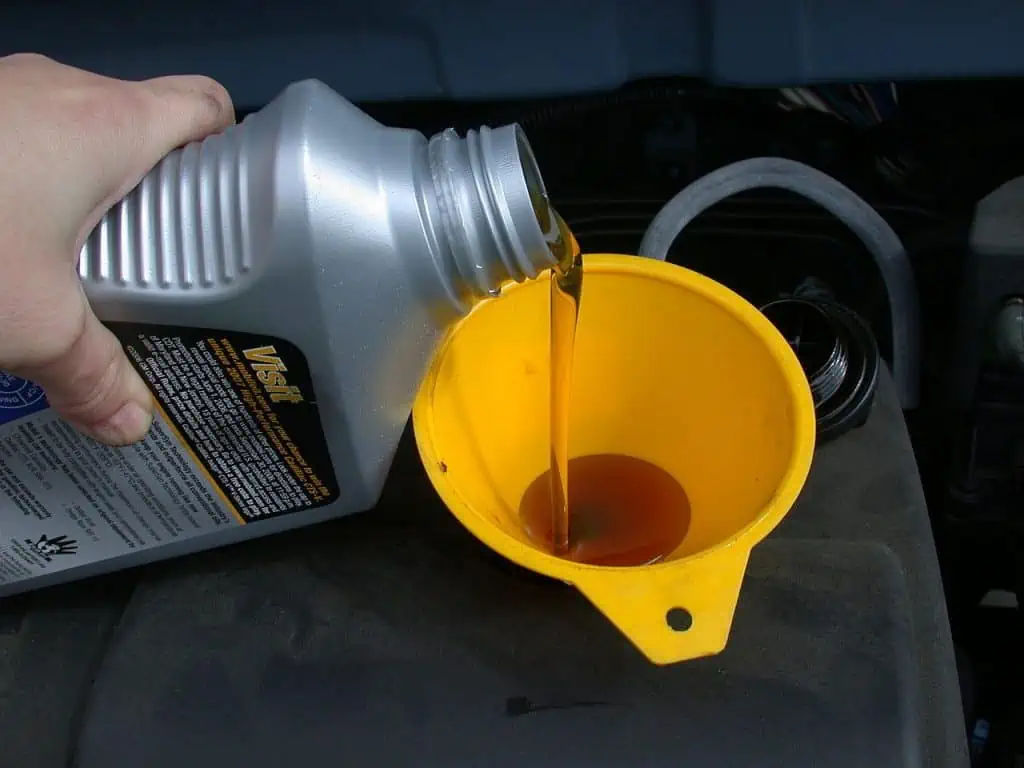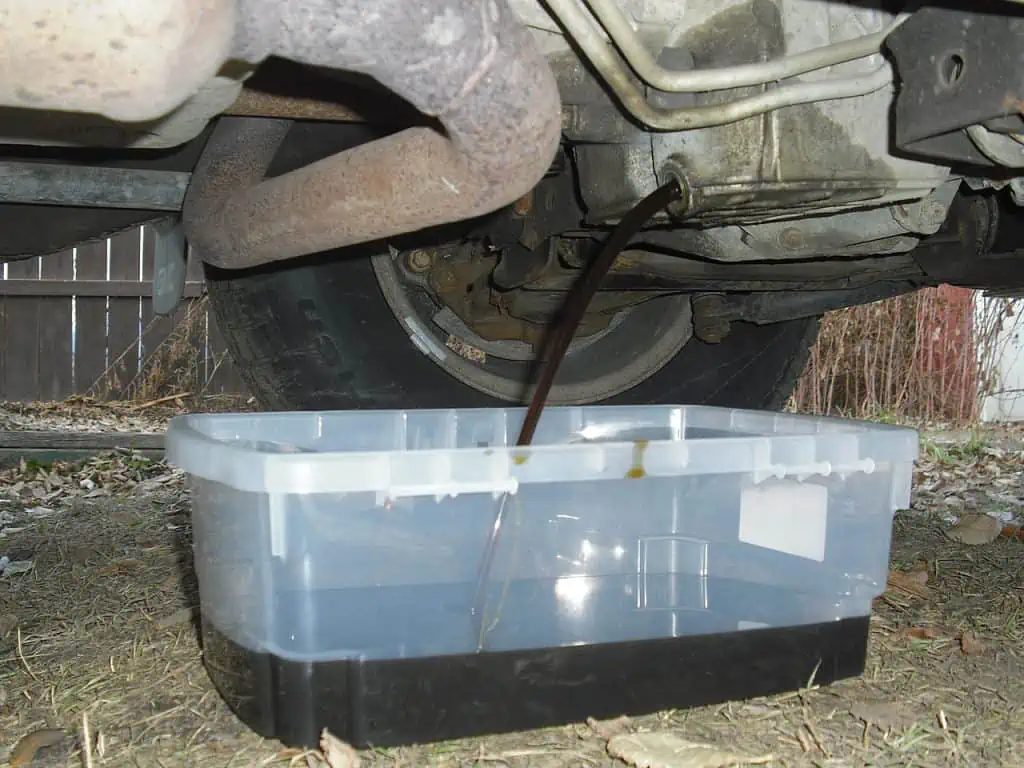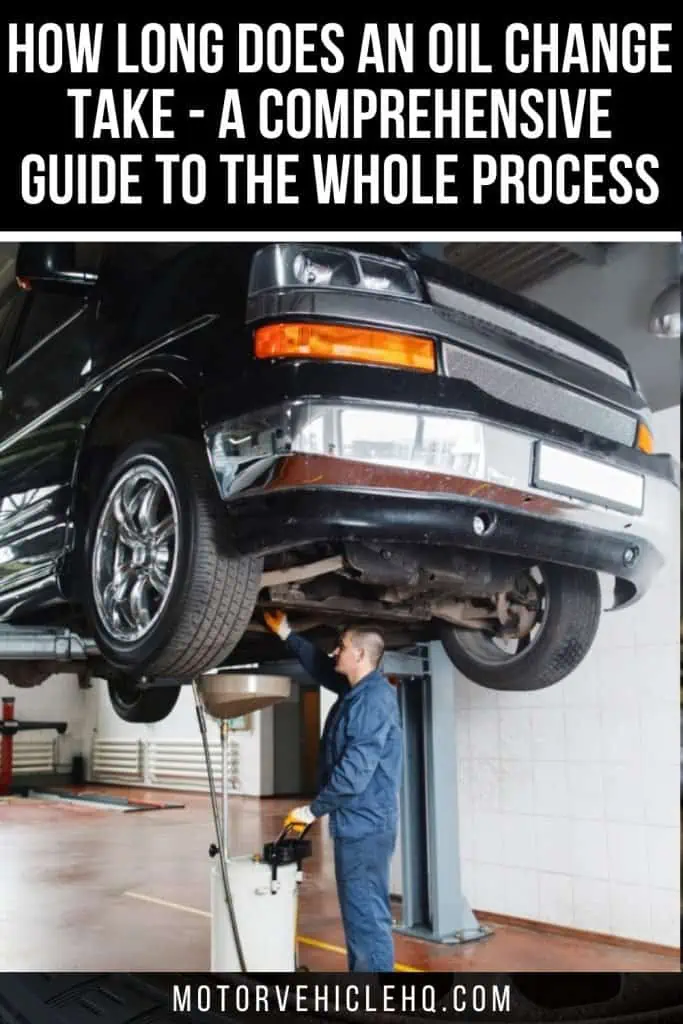There appear to be numerous approaches to changing the oil in your car. Some take longer than others, while others are easier.
You’ll undoubtedly be curious to learn how long an oil change takes, why it’s crucial, and many other details. Every 3,000 miles, car oil changes are typically conducted.
Given this, it is safe to say that the majority of people take roughly 30 minutes to change their car’s oil. However, you could have to spend up to an hour changing the oil in some cars because they need them more frequently.
Because the cost of repairs includes both the money you spend and the waiting time, it is crucial to comprehend how long it takes a qualified mechanic to change the oil on your car. On the other hand, your car’s oil change is finished.
You may therefore choose exactly where to have the oil change done by knowing which method—doing it yourself or having a qualified mechanic do it—takes longer.
One of the fundamental repairs that every motorist should perform occasionally is an oil change. For the time being, all we can say is that it is imperative to perform routine oil changes on your vehicle, regardless of its age, model, or make.
If you purchased a used vehicle without the knowledge of its prior maintenance history, you should have the oil changed right away. You must comprehend that this issue is more intricate than that. Remain tuned.
An Oil Change: What Car Maintenance Practice Is It?
An engine oil change is a procedure of draining the old engine oil and replacing it with fresh. The most crucial factor that all drivers should take into account is included in routine maintenance.
Remember that a vehicle’s oil needs to be changed after a certain number of miles. When this step of maintenance has to be done, modern cars will indicate a dashboard notification or light.
New (left) and used (right) oil filter by Petrb / CC BY-SA 4.0. Gaining access to two objects during an oil change is the objective. The drain bolt for changing the oil is the first, and the oil filter is the second. You won’t be able to complete the oil change if you don’t take care of both of these.
When you reach the mileage indicated in the owner’s manual for an older vehicle, you must note it down and change the oil.
A car’s oil should be changed ideally every 5000 miles or every six months. You still need to replace the oil even if your automobile is sitting for a few months.
This is strongly advised because the oil will lose its quality when not in use and will no longer be suitable for use.
Even though an engine failure is likely, you can still drive a car with outdated oil. So how long does it take to change the oil? Typically, it takes up to 20 minutes, sometimes even less.
You will only pay $100 to $120 for an oil change, which is not much. In other circumstances, you’ll need even less money if your car has a smaller engine block.
On the flip hand, we have the expense of engine failure brought on by outdated and subpar engine oil. You could be out up to $10.000 for this fix. You’ll need to completely rebuild your engine, which will be very expensive.
The bottom line is that an oil change is a quick maintenance procedure that may keep your engine healthy for many years to come. It only takes a few minutes. You must do this; it is not something you should do.
Why Is an Oil Change Important for a Car?
You can read everything about the advantages of getting your oil changed here. There are five primary factors, and you will gain from each, in brief. Remember that you also need to replace the oil filter.
It must be changed every time you change the oil because it is a necessary step in the process. Anyway, the significance and advantages of an oil change are shown here.
1. Greater Engine Lubrication Is Provided
Knowing when to change the oil is important, but you also need to understand why. This is the primary cause. To increase the lubrication of the moving engine parts, engine oil is employed.
Since there won’t be any lubrication without oil, engine parts will start to deteriorate right away. This is the main cause of a car’s limited engine oil-free operating time of two to three minutes.
2. Aids In Engine Cooling
The heat from the parts is also transferred using engine oil. They will generate friction while operating, which is converted into heat. The moving parts may become overheated as a result of this heat altering their chemical composition. All that heat will simply be removed by the engine oil.
3. Removes the Debris and Grime
The ability of new oil to remove debris from the engine is one of the most significant advantages of changing the oil on schedule.
This implies that over time, used oil will degrade into sludge and combine with the usual engine particles to create a heavy mixture.
The spin-on oil filter on a Saab by Ballista / CC BY-SA 3.0. Bad oil typically has a malfunctioning oil filter in it. Because of this, your engine won’t get enough oil to cool and lubricate its internal working parts. Your engine’s temperature increases as a result of the friction produced when these parts aren’t lubricated.
As oil flows through the oil filter, dirt and other contaminants are removed. Over time, old oil loses this quality and transforms into a smear.
4. Higher Fuel Efficiency
Did you know that you can increase the gas mileage of any automobile with routine oil changes? Generally speaking, you might anticipate up to 2% improved gas mileage. This translates into a gallon of fuel saved for a year. Any form of oil, whether synthetic or not, has all of these.
5. The Lifespan of the Engine Is Enhanced
This advantage was produced as a result of all the others, not as a standalone benefit. You can finish the procedure in 10 minutes using a basic oil change toolkit.
However, the engine will function and endure considerably longer. We can observe that this is the key factor influencing people’s attention to oil changes and their search for premium motor oil.
Mileage vs. Oil Change Time
Here, we’ll pay special attention to the mileage or time between oil changes. This indicates that in two situations, you should change the oil.
The first one happens when you travel a certain distance, and the second one happens after a certain amount of time. As you’ll soon discover, these two criteria are not related to one another.
How frequently should my synthetic oil be changed? You should change any oil after 5000 miles for optimum results. Although it can appear premature or similar, frequently changing the oil will significantly extend the life of the vehicle and its engine.
Although you can change the oil again after 6,000 miles, this suggests that the engine may already be suffering some harm.
Some of you might think it’s best to change the oil every two years. Every six months, the oil needs to be changed. Yes, you will spend more money on a car each year if you do this, but the engine will last a lot longer.
The engine will run on old oil for 1.5 years if you change the oil every two years. You shouldn’t do this, and you really should try to stay away from it.
These two qualifying components are unrelated, as we stated, and this is the case. After a certain number of miles and time, you must change the oil. Additionally, this implies that you need to change the oil twice a year.
Remember that the timer will reset once the oil has been changed. After six months have passed after the initial oil change, and you will need to change it if you don’t drive your automobile.
How Long Does an Oil Change Take?
An engine oil change is a straightforward procedure that doesn’t call for any particular equipment. Basic tools and a kit are required. The set of oil and oil filters is referred to as a kit.
Spin-on oil filter, showing an annular seal and screw-on thread by Nutzdatenbegleiter / CC BY-SA 4.0. This suggests that used oil will eventually turn into sludge and combine with common engine debris to form a heavy mixture. The oil filter removes dirt and other impurities as the oil passes through it. Old oil eventually loses this characteristic and turns into a smear.
The air filter may also need to be changed, but that is a different subject. You may find an in-depth step-by-step tutorial on how to change a car’s oil below. We can now add that it’s never a good idea to replace the oil in a hot engine. Start it after allowing it to cool.
Process of Oil Change
The procedure is simple in and of itself. Simply drain the old engine oil, swap out the oil filter, and add fresh oil. The entire procedure can be completed anywhere in a matter of minutes.
In a well-equipped garage, the car will be raised using a sizable car lifter. Yes, it simplifies things, but you are not required to use it. You can employ a standard car jack.
The objective is to be able to drain the oil by getting to the oil change bolt on the engine’s bottom. You will typically only need to raise the automobile a few inches. Even without lifting, certain SUVs can be moved.
You’ll need the following equipment:
- A carjack
- A drain bolt socket
- An old container
- A bottle of fresh oil
- A new replacement oil filter
- An oil filter wrench
- A flashlight
DIY Oil Change Instructions
Now is the time to show you how to change the oil yourself in the comfort of your own home or garage. Remember that before moving on to the next stage, you must finish all the steps we’ve listed below and fully comprehend them.
Make sure you finish each step completely and never miss a step. Starting with the fundamentals, I’ll walk you through progressively difficult stages. Remember that the procedure will take about 20–15 minutes to finish.
Step 1: Place the Vehicle In a Level Area
Here, we may observe a variety of possibilities. The first is that some drivers prefer performing oil changes on rocky terrain so they can drain more of the used oil. Although it’s a nice touch, this is nearly meaningless.
On flat ground, the engine is intended to be drained of oil. It will be completed by a qualified garage so you can gain more insight. You don’t need to park your automobile on an uphill or downward slope so you can empty the excess oil.
Always provide enough room to use a carjack when parking a car. The next procedure is a little different, so first, secure the automobile using a parking brake. Remember that the automobile cannot be started without engine oil.
No, you can’t even turn the ignition on, let alone start it. If you do, you risk damaging the engine, which would be a costly failure and incur huge costs. So let’s proceed to the next phase.
Pouring fresh motor oil into an engine by Aaberlanga / CC BY-SA 4.0. The process of emptying the old engine oil and adding new oil is known as an engine oil change. Routine maintenance is the most important element that all drivers should consider.
Step 2: Lift the Vehicle
You don’t need the carjack if you drive an SUV or a high-clearance custom vehicle. On the other hand, the majority of our vehicles are regular, so a carjack is required to lift them.
You can lift the portion of the automobile that contains the engine by placing the carjack securely in position. You can also use a car lift, which can have two or four posts. You should be familiar with how to load the automobile onto the lift.
Lifting the front of a car without realizing the engine is on the back or vice versa is a common mistake.
Here, gaining access to two items is the aim. The oil filter is the second one, and the first one is the drain bolt for changing the oil. If you don’t take care of both of these, you won’t be able to finish the oil change. How long does it take to change the oil? These two actions will determine it the most.
Step 3: Allow the Vehicle to Cool
Draining the oil from a hot engine is one of the most typical errors. There is a significant problem with this error. Oil is used by the hot engine to cool it down. The temperature of the engine parts will be substantially higher if the old oil is immediately drained. As a result, the seals may suffer damage or even worse.
You are not required to wait for a set period. It only needs to be left for a few minutes, depending on the temperature. Draining the old oil is a good place to start once the engine is cold enough for you to touch it.
Step 4: Remove the Used Oil
Find the bolt for the oil drain. It will be the engine’s lowest position and resemble a standard bolt. Place a jar or any other suitable object to collect the used oil. Here, it is important to note that it is against the law to change a vehicle’s oil on public property in several states or nations.
You should carry out this activity in the comfort of your garage because it isn’t safe either. We shall address how much oil you require for an oil change below. Now concentrate on the contested step.
Use the socket and the wrench to remove the drain plug after you’ve positioned the container beneath it. Make sure you use your fingers for the final few actions.
When the bolt is loose, the oil will begin to flow and press the bolt. This implies that the bolt can fall into the container. You’ll need to figure out what that implies, which entails pushing your palm through a lot of oil.
Allow the oil to drain for a few minutes. When the old oil stops dripping and the container is full, you are prepared to restart the operation. After finishing, clean the bolt.
It has a magnet at the bottom, as you can see. Before they get to the moving parts, it is utilized to trap tiny metal particles and hold them in place. After removing them, tighten the bolt after cleaning it. Don’t overlook this section.
Step 5: Uninstall the Old Oil Filter
The previous oil filter can now be eliminated. It’s usual for a few oil drips to fall; this is not abnormal. All you have to do is remove the oil filter in question using the socket intended for it. It will just take a few seconds, and it will be a very simple step.
Using a funnel to assist with a motor oil refill by Dvortygirl / CC BY-SA 3.0. An oil change is one of the basic maintenance tasks that every driver should occasionally complete. All we can say is that regardless of the age, make, or model of your car, periodic oil changes are essential.
Ensure that the old oil filter is upright and that the old oil has been drained from it. The same container may be utilized. If this is a new problem for you, you might need to learn how to unstick an oil filter.
Step 6: Mount the New Oil Filter After Adding Oil to It
The top rubber seal on the new oil filter should now be lubricated and filled with oil. Although not needed, this step is crucial.
Once you’re done, the likelihood that the engine will operate with low oil levels will be reduced. You are now finished with this step; all that is left to do is mount the new oil filter to the engine.
You don’t even need the socket or a wrench; you can simply tighten it down with your fingertips. After some time, the oil filter will automatically tighten. However, tighten it down with a socket if you’re a beginner and want to be secure.
Step 7: Add Fresh Engine Oil
This part is tough. You risk overloading the engine if you pour all of the fresh oil into it. The excess of it will need to be drained, which is annoying and difficult.
To do it correctly, you must pour oil until it reaches the oil dipstick’s lowest point. Then add it gradually, making sure it reaches the oil dipstick’s top point. Although you could need a lot of oil in particular situations, most cars only require a little amount.
Step 8: Perform a 10 Seconds Engine Start
The automobile will need to be started for 10 seconds. Here, lubricating and moving oil through the engine’s components are the main objectives. The engine oil light will also be seen to switch off after a brief period. When you’re finished, carry on to the following action.
Step 9: If More Oil Is Required, Add It
You will need to turn off the automobile and wait a few minutes without using it. Then, using the dipstick, determine the oil level once more and add more oil as necessary to reach the maximum level.
You will almost always need to add additional oil, although, for the majority of cars, 100ml or even less is sufficient. Avoid adding too much oil or you will need to drain it again. You have completed the procedure for changing the oil.
Why Does an Oil Change at Quick Lube Shops Take Less Time Than at Other Repair Shops?
It is not unexpected that quick lube shops perform oil changes faster than other service facilities. This is so that they can only perform oil changes at these quick lube stores.
It takes less time to register and for them to complete office work because these shops do not require any prior setup for the workstation and assume that every customer is only there for an oil change.
On the other hand, other repair companies might also perform tune-ups, tire pressure checks, coolant level measurements, and other simple fixes in addition to an oil change.
As a result, when you go to a typical repair shop, they have to take their time figuring out and writing down all the services you’re interested in. they might have to adjust the shop layout a little to make room for additional repairs.
Oil is being drained from a car into a drip pan by Myke Waddy. If you want to know the exact frequency for a particular vehicle, we urge you to reference the owner’s manual for your car as this frequency is merely a suggestion. Recommendation intervals for routine maintenance, such as oil changes, should be included in the manual.
Therefore, it’s crucial to consider your visit’s purpose when estimating the time needed for an oil change. Are you going for the oil change only, or are you also planning on getting some normal maintenance done?
You must go to a regular repair shop even if it takes longer if that is your goal. On the other hand, a quick lube business can be a better choice for you if the latter is your objective.
Can I Change the Oil On My Own to Complete This Job More Quickly?
Yes, changing your oil is the greatest way to avoid paying for labor if you want to save money on an oil change.
However, as we already explained, changing your oil is not advised if you want to save time on the oil change. Even if you had changed your car’s oil previously, it would still take you close to an hour to complete the task because DIY projects rarely succeed the first time.
When Is an Oil Change Necessary for My Vehicle?
Depending on the year, make, and model of your car, you may need to change the oil. Having said that, auto experts advise changing your engine’s oil every three months or after 3,000 miles.
We advise you to consult your car’s owner’s manual if you want to know the precise frequency for a specific vehicle because this frequency is only a suggestion. The manual ought to include recommended intervals for normal maintenance like oil changes.
It’s also crucial to keep in mind that occasionally you might need to change your car’s oil more frequently, particularly if you travel in rough or unpaved areas where your car is more likely to take up contaminants and other foreign objects.
On the other hand, if you don’t drive your car very often or only use it on paved, clean city streets, the 3,000 miles may come up pretty quickly.
The type of oil you use will also affect how often you should change it. For instance, you may wait up to 10,000 miles if you use synthetic oil. Synthetic oil costs a lot more money than normal oil, though. Therefore, unless your vehicle’s owner’s manual specifically instructs you to use synthetic oil, automotive experts do not recommend doing so.
Is It Safe to Drive a Car Without Performing an Oil Change?
Whether you can drive your car to the closest repair facility depends on how far you had to travel since your previous oil change. If it was only a few miles, you might be able to do so.
However, if you haven’t changed your oil in a while, doing so is risky, and doing so will only result in the engine of your car being destroyed.
A faulty oil filter is frequently included in bad oil. Your engine won’t receive enough oil as a result to cool and lubricate its internal working parts. Because of the friction created when these parts aren’t lubricated, your engine’s temperature rises.
A certain range of temperature is required for your engine to run, and if the temperature increases too much, your engine is likely to be harmed.
Therefore, consider the time and effort you will use to fix your engine if you decide it isn’t worth the money or that you don’t have time to replace the oil right now.
A truck’s oil is being drained at an oil change shop by Aaberlanga / CC BY-SA 4.0. An oil change is one of the most common maintenance tasks that every driver must occasionally complete. Understanding how long an oil change takes is essential. This will give you the option of performing it yourself or bringing your car to a shop for a qualified repair.
What Engine Oil Is Best for My Vehicle?
The proper oil to use is specified in the owner’s handbook of every vehicle. The viscosity of the appropriate oil is typically indicated by these criteria, such as 5W-20 or 10W-30.
For more precise information, it is, therefore, preferable to start with the owner’s handbook of your car.
The Conclusion
One of the most frequent maintenance that every motorist has to make from time to time is an oil change. It’s critical to comprehend how long an oil change takes. This will enable you to decide whether to perform it yourself or take your vehicle to a professional repair facility.
Most automotive experts agree that among all your options, changing your engine’s oil yourself takes the longest—about one hour.
On the other side, of all the options available, getting your oil changed at a quick lube store takes the least amount of time. If there aren’t any other customers waiting in line ahead of you, these quick lube repairs can be completed in as little as 15 minutes.
Regardless of the method, you selected to get your car’s oil changed, you must replace your oil when it needs to be changed to prevent overheating from damaging your engine.
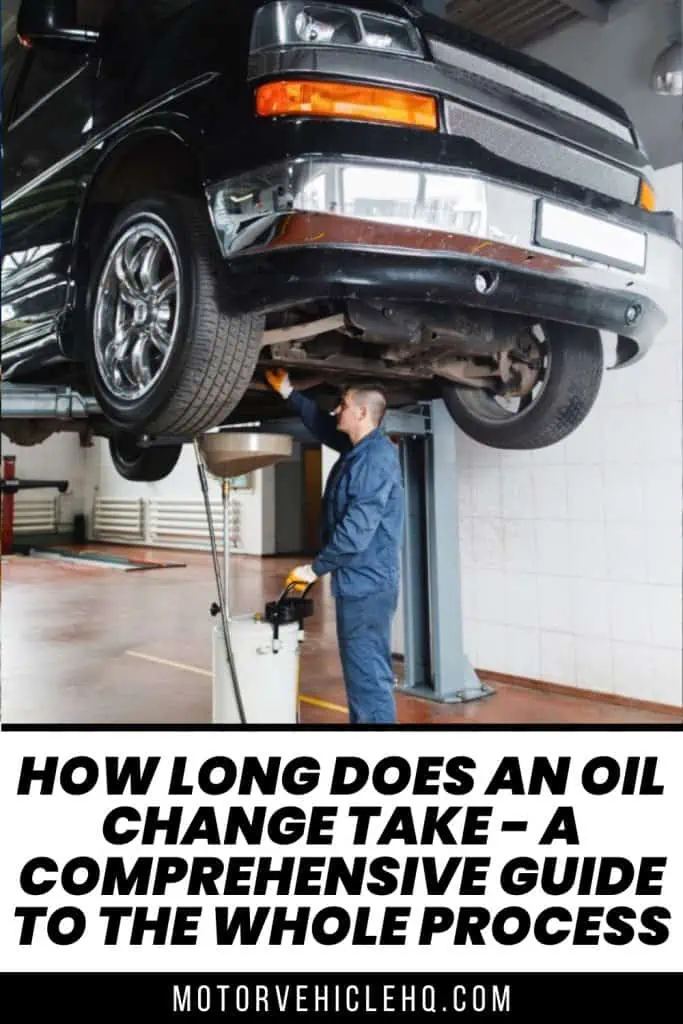
A truck’s oil being drained at an oil change shop by Aaberlanga / CC BY-SA 4.0

Jim Wicks is the founder of MotorVehicleHQ. With over two decades of experience in the automotive industry and a degree in Automotive Technology, Jim is a certified car expert who has worked in various roles ranging from a mechanic, car dealership manager, to a racing car driver. He has owned more than 20 cars over the past 15 years. Ask him about any vehicle you see on the road and he can tell you the make, model and year. He loves the aesthetics of all things cars, and keeps his vehicles in pristine condition.
In his free time, Jim enjoys getting his hands dirty under the hood of a classic car or taking long drives along the country roads. His favorite car? A 1967 Shelby GT500, a true classic that, according to Jim, “represents the pure essence of American muscle.”

